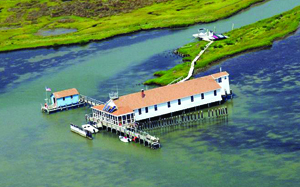By Linda Cicoira —The circa 1929 hunting and fishing lodge that turned into an Environmental Education Center on Great Fox Island more than four decades ago is in its last season. It will close sometime in December due to sea level rise.
About 70 percent of the island is already gone. Once nearly 360 acres, it is down to 34. What’s left is less than 24 inches above the surf. It will likely be sold, and classes will move to the Port Isobel Island facility near Tangier.
Fox Island is a string of marshes in the midst of the Tangier and Pocomoke sounds and accessible via Saxis Harbor. The lodge was built by the Fox Island Rod and Gun Club and was later donated to the Chesapeake Bay Foundation.
Elsworth Linton, of Saxis, remembers hunting the area with his dad, Dulany Linton, when the younger Linton was 12, 13, and 14 years old. He’s 95 now. “It’s washing away bad,” he said of Fox Island. “When it blows it washes the dirt and sand somewhere else.”
Linton was a waterman and bought and sold crabs. “I’ve seen it all,” he said. “I think it’s rising more all the time. Been going on ever since I was a boy. The high tides. Every time there was a storm, it would flood up there,” he said of parts of Saxis.
Despite the changes that come with the rising sea levels, Linton said he’s made it to his age because of the water. “Saltwater makes you live longer. It keeps everything.”
According to the foundation’s website, “From its unique perch in the middle of the Chesapeake, we’ve provided life-changing learning experiences for tens of thousands of the watershed’s teachers and students for more than 40 years. Many of them went on to pursue careers in science, public service, education, and environmental advocacy. It’s a testament not only to the magic of the island but also to the exceptional cast of CBF educators and staffers who stewarded its shores for so long.”
“It’s hard to imagine CBF without it,” the website continued. “Fox was our first residential education center. It had an outsized role in shaping the immersive, experiential learning that is the hallmark of our environmental education programs.”
Sea level rise is affecting more than the islands. Carroll Lee Marshall, a local carver, said, “Saxis doesn’t get flooded nearly as much as Sanford does.” After getting water in his house that was up four cinderblocks high, they lifted the house to 11 blocks and put in 270 loads of fill dirt in 2003. “We just like Sanford. We enjoy it,” he said of him and his wife.
The sea level rise “doesn’t bother duck hunting too much,” Marshall continued. “The ducks are decreasing. We don’t know why. Don’t know if they are getting fed up north or are going to irrigation ponds that have been dug” locally. “When I hunted, I hunted on the regular marshes. There are still hunters going to Cattail Creek and Messongo Creek and around Saxis,” he said.
The foundation says coastal Virginia has seen the highest rate of relative sea level rise on the Atlantic coast with more than 14 inches since 1930. “The Hampton Roads region is particularly at risk because, in addition to rising seas, the land is also sinking. In coastal Virginia, recurrent floods already inundate city streets and homes, while frequent storms batter infrastructure. The good news is that there are ways to adapt to recurrent flooding, as well as address rising waters, using nature-based solutions … Large scale shoreline protection techniques like living shorelines, living breakwaters, and oyster reefs, all stabilize the waterfront against the force of waves and storms. Smaller-scale techniques, like rain gardens, tree boxes, vegetated swales, permeable pavers, rain barrels, and downspout disconnections, hold and filter rainwater into the ground rather than letting it wash off hard streets and buildings and into creeks and rivers.”



